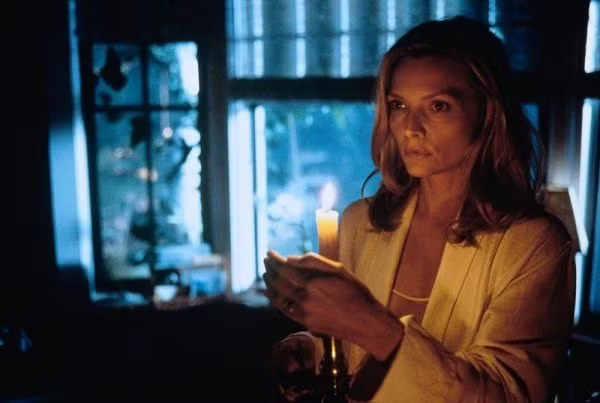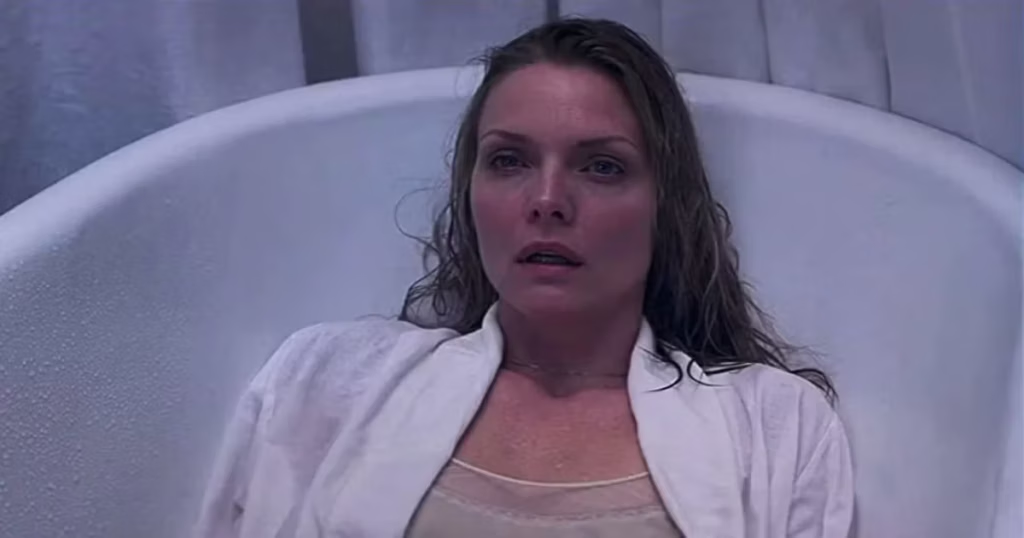“Something is happening in our house whether you like it or not!”

The 25th anniversary of director Robert Zemeckis’ 2000 horror hit What Lies Beneath is something of a momentous occasion. If you were of a certain age when the movie first came out, then you’d never thought such an anniversary would ever come. But it has been 25 years and all memories associated with What Lies Beneath now represent just how much the movie business has changed. Back in 2000, a $100 million ghost story starring two bona fide movie stars that came out in the prime month of July was the norm. Nowadays, not only are such movies made for fractions of that budget, but they typically come out in lower-profile times of the year with much less fanfare; if a movie akin to What Lies Beneath even exists at all anymore. But Scream Factory’s new release of the Zemeckis classic harkens back to a time when movies of this size and scope were considered summer blockbuster fare, vehicles for true blue movie stars, and blank canvases for directors to see where their sensibilities could run wild.

From a script by Sarah Kernochan and Clark Gregg (yes, that Clark Gregg), What Lies Beneath focuses on happily married couple Claire and Norman Spencer (Michelle Pfeiffer and Harrison Ford), who enjoy a blissful life on their Vermont lakefront home. However, with their daughter off to college and Norman’s work at the university taking up most of his time, Claire finds herself struggling with ways to fill her days. Soon, she begins to overhear shouting and arguing coming from the new neighbor’s home, eventually leading her to suspect that the lady of the house (Miranda Otto) has been murdered by her husband (James Remar). As she begins to investigate the goings-on next door, Claire also starts to experience ghostly occurrences around her home.

Right from the start, many were quick to brand What Lies Beneath as a Hitchcock homage because of both the movie’s genre and the director at the helm. Hitchcock, much like Zemeckis, was a showman of the movies, a filmmaker who embraced technical innovations and sought to see how far his instincts as an artist could go. In honor of both these directors and the anniversary of one of the most entertaining films of the decade, I thought I’d explore the various ways in which What Lies Beneath sees one legendary director emulating another.

“There’s a ghost in my house.”
Hitchcock was very intrigued by the theme of the influence of the dead on the living. As seen in both Rebecca and Vertigo, the ghosts of women loom large over Hitchcock heroines Joan Fontaine and Kim Novak, respectively. While the former finds herself a replacement for her husband’s much-adored first wife, the latter finds herself drawn to a woman who existed centuries before she did. Claire herself eventually comes face to face with a ghostly presence she can’t escape, a woman who she eventually discovers looks just like her. The way she becomes transfixed by this unknown woman and what might have happened to her is the heart of What Lies Beneath and Claire’s haunting relationship with the ghost becomes almost as strong as the thrills themselves.

“I think she’s starting to suspect something.”
The biggest commonality between Hitchcock and Zemeckis was their penchant for experimentation. Plenty of Hitchcock classics, including Notorious, Rope, and Psycho, among countless others) saw the director expand his cinematic language in ways that were revolutionary, influential, and remain impressive today. Zemeckis has continued that spirit throughout his career with Death Becomes Her and Contact as two prime examples. Here, the director embraced new technology to make the closing of a door and the point of view of lying helpless on the floor look inventive while not disrupting the film’s reality. But it’s the morphing of Pfeiffer’s face with the dead woman haunting her where Zemeckis’ curiosity and showmanship is at its absolute best here, making for one of the movie’s most iconic moments.

“Did you know her?”
A theme that Hitchcock tackled only once, yet quite memorably, was that of a wife uncertain of her husband. Fontaine gave one of her most memorable performances as the wealthy, paranoid newlywed who begins to suspect that her new husband might be trying to kill her in Hitchcock’s Suspicion, the pair’s creative follow-up to Rebecca. It’s a magnificent turn from the actress which won her an Oscar, making her the only performer to win the award for a Hitchcock movie. It’s easy to see shades of Suspicion‘s Lina in Claire, who begins to wonder just how much Norman knows about the dead woman in question. Her distrust of Norman is no doubt influenced by the ghost taking her over, but watching Claire start to question how much she knows about the man she’s married to gives Pfeiffer some great moments to play.

“What are they doing next door?”
Voyeurism has been a keystone for Hitchcock in many of his films, most notably Rear Window and Vertigo. In those films, the characters played by James Stewart revel in the act of watching the people around them, taking in various aspects of their existence in quests for answers and information. Claire easily channels Stewart’s Jeff and Scotty with her need to know what might have happened in the house next door and who the ghost taunting her might be. It’s a burning desire to uncover the mystery through careful, yet relentless observation that fuels Claire and carries her towards the truth. Both Zemeckis and Hitchcock present takes on voyeurism that in essence turn the tables and remind movie audiences that we become the biggest voyeurs of all whenever we sit down to watch a movie.

“Something is happening to me!”
Perhaps the most identifiable trademark of most Hitchcock movies was the Hitchcock Blonde. The director was always fascinated by the image of the beautiful blonde who is forced to shed the cool iciness and enter a world she never thought she’d find herself in. Every blonde who worked for Hitchcock, from Grace Kelly to Janet Leigh to Tippi Hedren, fit this mold in her own special way. Pfeiffer is a clear successor to these ladies, starting out in What Lies Beneath looking luminous and serene until the ghostly events in her home force her to embark on a journey that has her, as Pfeiffer herself puts it: “battling her own subconscious.” Ford may have gotten top billing, but Pfeiffer is the secret weapon here, charting Claire’s spellbinding journey into the afterlife with great intensity and commitment while remaining one of the most beautiful stars the screen has ever seen.

One aspect that Hitchcock never would have stood for is the horrible marketing job that was done for What Lies Beneath. While the poster is still as effective as ever, the movie’s trailer remains infamous for the way it revealed several key twists, most of which rendered the entire first act largely inconsequential. Hitchcock would’ve balked at the trailer fiasco, but no doubt applauded everything else (especially the Psycho homage Zemeckis pays him with that tense bathtub sequence) the way audiences did back in 2000.

Not only was What Lies Beneath the hit that both Pfeiffer and Ford needed (the previous year’s The Story of Us and Random Hearts stalled at the box office), but it also ended up becoming the 10th highest-grossing film of the year. Such a feat is nearly impossible nowadays. Summer blockbusters haven’t looked like What Lies Beneath for quite some time and even Zemeckis himself has largely stayed away from that kind of original big-screen character-driven spectacle in recent years, preferring instead to put his unique spin on classic titles. But What Lies Beneath existed when it needed to, and despite the differences that have taken place in the movie landscape over the last 25 years, the experience remains one of the most effective and enthralling ghost stories to ever showcase the glorious past, present, and future of moviemaking.
What Lies Beneath is now available on Blu-ray and 4k from Scream Factory.


